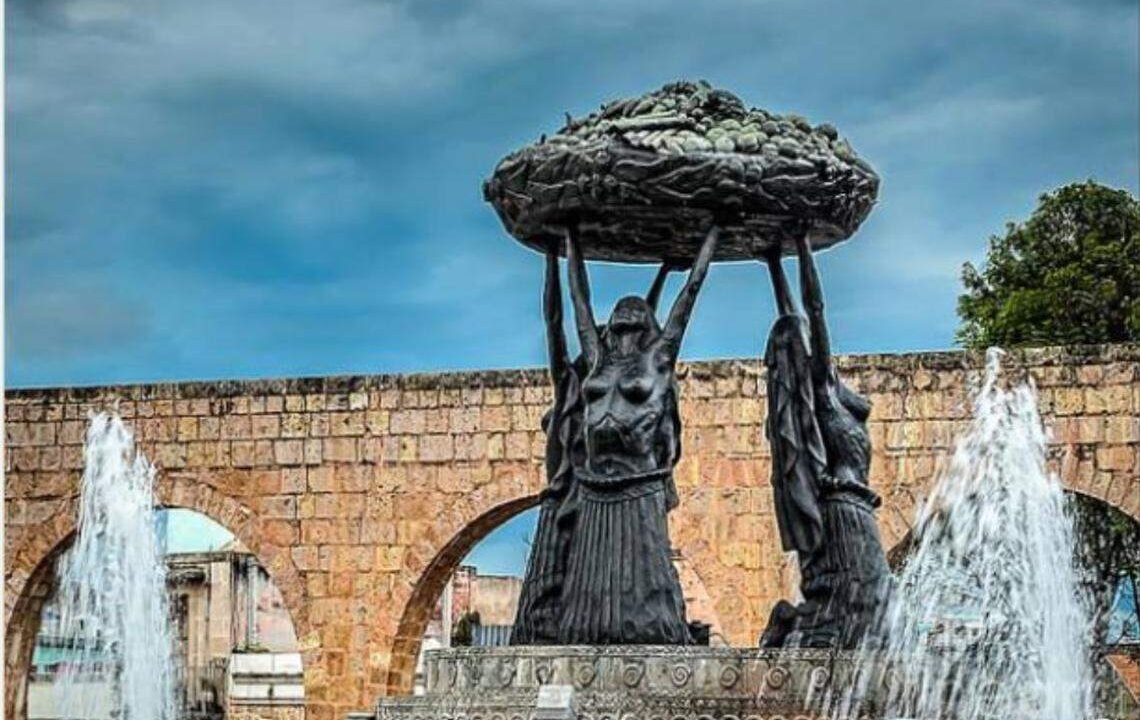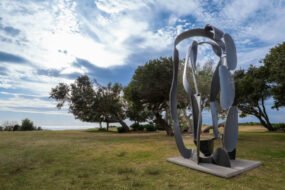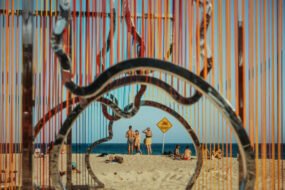
Finally, after 12 years in storage, a sculpture of three bare-chested women or princesses lifting a bowl of fruit to the sky — gifted to Kansas City from its sister city of Morelia, in Michoacán — may finally be going up.
The piece, “Las Tarascas,” is a replica of the famed fountain, “Fuente de las Tarascas,” created by artist Jose Luis Padilla Retana in 1984. His work, in turn, was a bronze version of a colorful fountain made of cement, also depicting the three kneeling women, and which, from 1931 to 1965, had been on display at the center of Morelia.

One of three female figures that make of the sculpture Las Tarascas, given to Kansas City by sister city Morelia, Mexico, has been in storage in KC for 12 years. The sculpture has been slated to be installed on Southwest Boulevard.
Sister city gift
In 2013, Morelia gifted Kansas City with the bronze replica in celebration of the 40th anniversary of Kansas City’s and Morelia’s sister city relationship.
The figures, however, were never put on permanent display, despite years of lobbying.
Joe and Gloria Bessenbacher of Shawnee, the chairs of the Morelia sister city committee, pushed to place sculpture on city land near the Sister Cities International Bridge, a foot bridge along the Country Club Plaza.
“Actually, I am truly disappointed that this very symbolic piece of art is not being placed on the Plaza, where it would have the visibility and importance it deserves,” Gloria Bessenbacher said in an email.
The structure has nevertheless been approved for installation on the West Side. Instead of on the Plaza, the Municipal Arts Commission approved it to be placed on Southwest Boulevard, reflecting the West Side’s Hispanic heritage.

Two of three female figures from the sculpture Las Tarascas in storage in Kansas City. The figured have been in crates for 12 years, since the sculpture was given as a gift to the city in 2013 from sister city, Morelia, Mexico. The sculpture has been approved to be installed on Southwest Boulevard.
Gathering dust
“Since the 2000s, the statues have been in storage gathering dust,” Nicolas Bosonetto, a city engineer with the Department of Public Works, said at a recent presentation before the commission.

Bronze bowl of fruit, part of the Las Tarascas sculpture given to Kansas City in 2013 from sister city Morelia in Mexico, sits inside a crate in Kansas City, where it has been in storage for 12 years.
“We went to visit them,” he said, showing slides of the figures in storage. “Here you see there’s three crates with the princesses in it, and one large crate with the bowl. It was very dusty. We started cleaning it out. We were amazed to find a beautiful bronze color.
“You see the details of the gords, the corn, of the native fruits. It’s just a shame that they’re sitting there gathering dust.”

Dust removed from bowl of fruit, part of Las Tarascas sculpture, shows its bronze color. The sculpture, a gift in 2013 from Morelia, Mexico, has beenin storage for 12 years.
Where the sculpture will be placed
The commission agreed, voting unanimously to install the sculpture at the recommended site, a triangular parcel just east of the Interstate-35 overpass, where Southwest Boulevard meets Avenida Cesar E. Chavez (W. 23rd Street) and West Pennway Avenue.
“I am very happy that the fountain is finally being brought out into the light in Kansas City, after more than a decade of being in storage,” said Jeremy Slagoski, president of the Sister Cities Association of Kansas City.
No specific date for the artwork’s installation has yet been set. Its placement is to coincide with a more expansive Southwest Boulevard reconstruction plan, which is to include bike lanes, stamped concrete sidewalks and landscaping, including more trees along the length of the boulevard.

Rendering of the placement of Las Tarascas sculpture on a triangle of land where Southwest Boulevard meets W. 23rd Street and West Pennway.
Bosonetto said that the city held multiple community meetings, including Spanish-only meetings, regarding changes to the area.
But it won’t be a fountain
“What they wanted for Southwest Boulevard is a place that is safe, accessible for all, and undeniably West Side,” he said. “They wanted to make sure to use banners, murals, signage to display Hispanic-American roots. And one of the recommendations was to put up art that is is very Mexican-American.”

Las Tarascas, a sculpture that was gift from sister city, Morelia, Mexico in 2013, is to be installed in a triangle park at the intersections of Southwest Boulevard, W. 23rd and West Pennway streets.
Commissioner Branden Haralson asked whether the plan was to make the sculpture part of the fountain, as it is in Mexico. A similar replica, also fountain, exists in Buenos Aires, Argentina.
Bosonetto, who noted that he is of Argentine heritage, said that the current plan does not call for turning the sculpture into a fountain, as fountains are notoriously difficult to maintain. He said, however, the idea for the sculpture arose directly from the continuous state of disrepair of the West Side Fountain, located on the west side of the I-35 overpass, and which was dedicated in 2001.

The West Side Fountain, installed in 2001, has been in a regular state of disrepair. A new sculpture is to be installed nearby as part of Southwest Boulevard reconstruction and improvement.
Princesses of legend
“The neighborhood was so upset that the fountain was let go and not being fixed,” he said. “So we wanted to do something for the neighborhood. That’s where this whole plan came out of . . .The West Side Fountain has a history. Basically, from the Parks Department perspective, it’s just, it’s almost impossible to fix. It wasn’t built correctly.”
Bosonetto said that the fountain may be turned into a “flower fountain,” filled with plantings as part of boulevard reconstruction. Other questions surrounded security for the fountain, upkeep and possible fencing.
The sculpture is not large, measuring 7-feet wide and standing 6-foot-6 inches high without a plinth. The original “Fuente de las Tarascas” in Morelia, created by artists Antonio Silva Diaz and Benigno Lara, was also referred to as “Fuente de las Indias,” for the Indian Fountain.
The female figures were not imbued with any larger meaning by the original artists. Government officials later changed the name to “Fuente de las Tarascas,” after the Tarascans, a the Spanish name given by colonists to the indigenous group found in the state of Michoacán. The people call themselves Purépecha.
Some have come to believe that the three women in the fountain represent three Purépecha princesses of legend, Atzimba, Eréndira and Tzetzangari. One was banished for falling in love with a Spanish explorer, another stood up against the Spanish conquistadors, while the third’s tears filled Lake Zirahuén.
Located about 200 miles west of Mexico City, Morelia is one of 12 sister cities to Kansas City. They include Seville, Spain (1967), Kurashiki, Japan (1972), Morelia, Mexico (1973), Tainan, Taiwan (1989), Xi’an, China (1989), Guadalajara, Mexico (1991), Hannover, Germany, (1993), Port Harcourt, Nigeria (1993), Arusha, Tanzania (1995), Ramla, Israel (1998), Yanán, China (2017), Metz, France (2025).

Two bronze castings of Chinese terracotta warriors stand just off the Country Club Plaza. A gift from Kansas City’s sister city of Xi’an, the statues were vandalized multiple times in their first year in Missouri.
In 2000, former Kansas City Mayor Kay Barnes dedicated the Sister Cities International Bridge, a pedestrian foot bridge over Brush Creek, along the Country Club Plaza. In 2004, two 6-foot-tall statues of Chinese soldiers — a gift from sister city Xi’an, and replicas of some of the 7,000 life-sized terra cotta warriors found at the tomb of China’s first emperor, Qin Shi Huang — were installed at the north end of the bridge.
In 2006, in Loose Park, a traditional Japanese garden was installed in a cultural exchange with Kurashiki, Japan.









